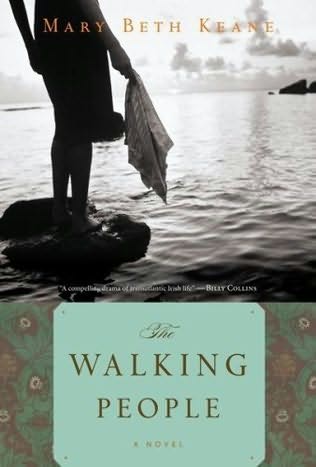
I haven't made or kept any New Year's resolutions in quite awhile. I haven’t read the 50 Greatest Books of the 20th Century (my 2000 resoution), gleaned from several turn-of-the-millenium lists on the internet. (Well, I have read some, but not lately.) I'm doing slightly better with forgotten lit: Viragos, Overlook Books, Persephones, Capuchin Classics, University of Nebraska, Phoenix Fiction, and out-of-print Pamela Hansford Johnsons. I'm behind on worthwhile pop: I have yet to finish R. F. Delderfield's God Is an Englishman, the 1970s romantic-industrial historical novel with the silly title which is my chosen bedtime-reading.
My spring resolution is simple: gamble on more contemporary literature. And I’ve hit the jackpot with Mary Beth Keane’s first novel, The Walking People, which I learned about in Joanathan Yardley’s fascinating review in The Washington Post (I trust him more than most reviewers). He didn’t rave, but he called it “thoughtful and appealing.” And that’s good enough for me from a demanding critic.
Actually, I like it better than Yardley did, but then I like immigrant fiction. There’s been a run on Indian, Chinese, and Russian immigrant fiction lately, but Irish immigrant novels seem to have fallen out of fashion. Keane's engaging, lyrical style has an echo of Irish-American storytellers like Frank McCourt and Alice McDermott. The narrative is very detailed and compelling and gradually quickens pace as the second half of the 20th century catches up with the characters: among the most charming scenes is the description of a celebration of electricity when it comes to rural Ireland in the early ‘60s, the excitement of the young, the fears of the old.
About a third of the novel takes place in Ireland in the '50s and '60s and two-thirds in New York from the late '60s to the present.
The prologue begins in 2007, with Irish-American Michael Ward’s retirement from work as a “sandhog” - digging water tunnels- in New York City after 37 years. No one throws a party, as he’d vaguely hoped, and only one friend takes him out for a drink. We learn that Michael started life as a traveler, or gypsy, in Ireland - a well-kept secret - and after he decided he’d like to settle down, worked on the Cahills' farm in an isolated part of Ireland, and then emigrated to America with two young women, Johanna and Greta Cahill.
Then, in Part One, we backpedal to rural Ballyroan, Ireland, in 1956, where we learn the story of Johanna Cahill, the mother of Michael's first child, and her younger sister, Greta, who becomes Michael’s common-law wife in New York. Johanna is adventurous, the one who initiates mischief as a child, but Greta, the cautious youngest daughter, is considered simple and backwards until in elementary school a health visitor discovers she needs glasses and she quickly catches up in school. Years later their father, Big Tom, a farmer, illegally fishes for salmon at night, as his necessary second job, and is tragically killed by an inspector, who shoots him in the dark, having intended to shoot over his head.
Thus begin the hard times for the Cahill family. The two oldest brothers go to Australia, since their mother fears they will be arrested, leaving their other brother ,Little Tom, who has a speech impediment, and their mother to run the farm. Michael works as a hired hand on the farm, and is shortly thereafter seduced by Johanna. The two girls work as maid and cook in a hotel. But because there is no business at the hotel - and there is nobody living in the area - they find themselves out of a job. But when a vivacious Irish New Yorker comes to Ballyroan to bury her mother, the aggressive Johanna schemes to go to New York, with Shannon as their sponsor. She pressures Michael, who is ambivalent. Her mother insists that they take Greta with her.
Michael gets Johanna pregnant - but after the baby, Julia, is born in New York, Johanna runs away, leaving the baby with Michael and Greta. Greta, who works by day at Bloomingdale's, raises Julia as her own, and is always frantic that Johanna will want her back. At one point, Johanna does file custody papers through a lawyer, but schanges her mind. Greta has two other children, but Julia is always special.
This is a very touching family story, capturing the rhythms of daily life, the slow turn of the seasons, marked by dramatic episodes: Greta’s losing her job, though she keeps the shameful reason secret; Michael’s serious injury on the job; and Johanna’s constant quasi-blackmail about Julia.
Obviously there are some conscientious reviewers out there.
2 comments:
I've just started this one today, but I'm still reading the prologue. It sounds interesting, and so far I've heard good things about it.
I hope you'll like it. I'm going to "swap" (virtually) with you and read Brooklyn. Your review made me really want to read it.
Post a Comment